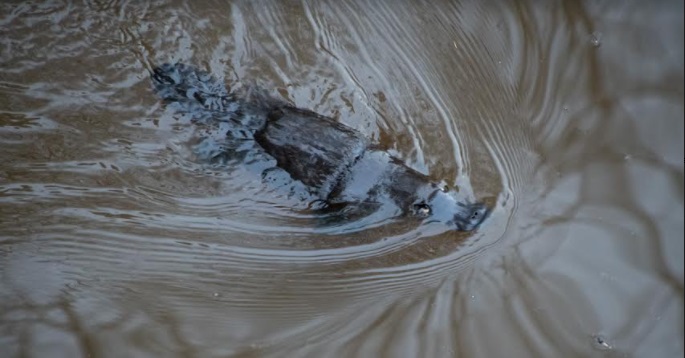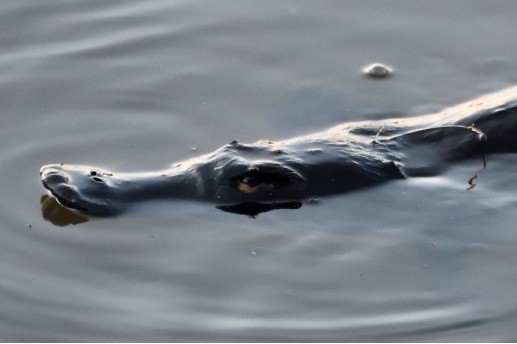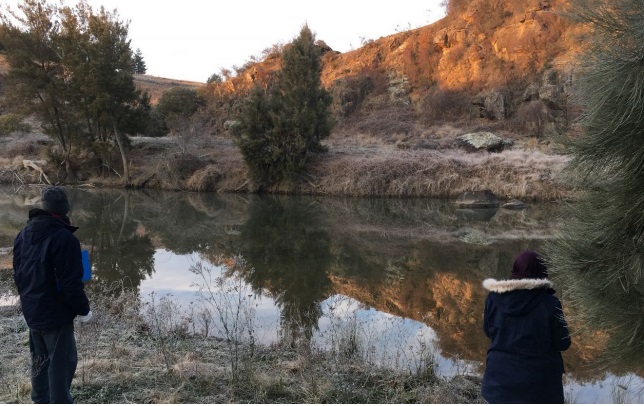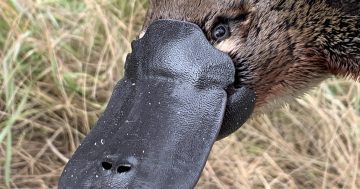
Platypus in Queanbeyan River with what appears to be a band around its body. Photo: Dylan Jones.
The shocking drowning death of a male platypus in Lake Jindabyne last week has struck a sympathetic chord on social media, but a far greater groundswell of support and action at all levels is needed to save the species.
At least that’s the message coming from researchers and conservationists after a tumultuous year where diminishing populations of the docile freshwater-dwelling mammal – which survived drought, but then faced destructive bushfires and floods – were thrust into the media spotlight as studies revealed just how bleak its future is.
Dr Gilad Bino, a researcher at the University of NSW Centre for Ecosystem Science, has been researching platypus in the Monaro/Snowy Mountains region for the past three years as part of the Platypus Conservation Initiative.
He was also the lead author of a UNSW study that examined the potentially devastating combination of compounding threats to national platypus populations, including water resource development, land clearing, suburban sprawl, climate change, pollution, predators and increasingly severe periods of drought.

Platypus at Jerrabomberra Creek with a fishhook in its back. Photo: David Cunningham.
The scientists’ models predict that populations may have declined by more than 50 per cent as a result of these pressures, and will collapse by up to 66 per cent in the next 50 years, and by 73 per cent by 2070, if they continue unabated.
The UNSW study precipitated the January 2020 call for action to prevent the platypus from disappearing completely from our waterways. In the same month, the International Union for Conservation of Nature (IUCN) downgraded the platypus’ conservation status to ‘near threatened’.
“There is an urgent need for a national risk assessment for the platypus to assess its conservation status, evaluate risks and impacts, and prioritise management in order to minimise any risk of extinction,” says Dr Bino.
Yet a voice from a riverbank near Cooma said people should never underestimate how much can be achieved with small steps.
“If I go out to a river and find a pool where the sand has washed in and covered all the habitat, I will put in my net, slosh around there and go to a bit of effort, and pull out hardly any bugs,” says Antia Brademann, coordinator for the ACT-based Upper Murrumbidgee Waterwatch.
“I go back to that pool and find that over time this little tiny bunch of reeds has established there. When surveyed, I found a whole heap of shrimp and water bugs just with that tiny little bit of habitat.
“That’s what I try to highlight to people all the time – we need to really protect habitat on a large scale, and it can seem hopeless, but we should never underestimate that even a tiny bit of habitat can make a change.”

A frosty platypus survey on the Molonglo River, below Coppins Crossing, by members of Upper Murrumbidgee Waterwatch. Photo: Upper Murrumbidgee Waterwatch.
Waterwatch is a national citizen science program involving landholders, community groups and schools which aims to engage communities in monitoring and protecting the health of local waterways.
Funded by the ACT Government and Icon Water, Upper Murrumbidgee Waterwatch maintains around 210 active sites in a 11,000-square-kilometre area, taking in the Murrumbidgee River and Yass River catchments upstream from Burrinjuck Dam.
Antia’s subcatchment covers Cooma, Numeralla, Bredbo, Michelago and the northern section of Kosciuszko National Park.
Ten years in the role, she’s all too aware of the gloomy future that awaits the platypus.
Each August – the most active feeding month for platypus – Antia and a steely group of volunteers brave the bitterly cold predawn mornings to monitor populations from established hides at eight survey sites across her region.
Platypus are largely nocturnal and shelter in burrows during the day. When they are active at night, they are often submerged in water, hunting for food. They’re very hard to spot.
“The home range for a platypus is around eight kilometres,” says Antia. “It needs 20-50 per cent of its weight in food a day so it will be using that eight kilometres to find and feed on water bugs.”
Repeating the surveys four times a month, the group uses this data to get an estimate of platypus numbers for that stretch of waterway.
“If a river system is healthy and there are lots of abundant water bugs, it can support better platypus numbers,” explains Antia. “If you have a challenged waterway where stream health has declined, you’ll see one individual.
“We’re finding a real squeeze point for platypus. The threats have always been there, but as pressures increase in the catchment we can see how that erodes a species.”
Antia says the most crucial step individuals can take is to be mindful of what’s in their backyard and become involved in efforts by groups such as Landcare to help improve river health.
Dr Bino suggests recording sightings and observations in the Atlas of Living Australia.








